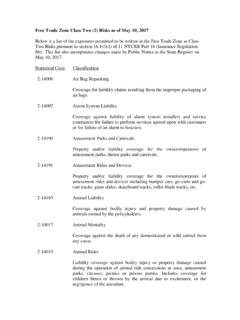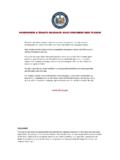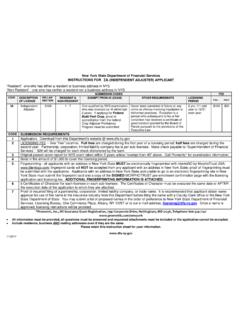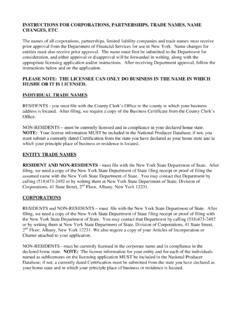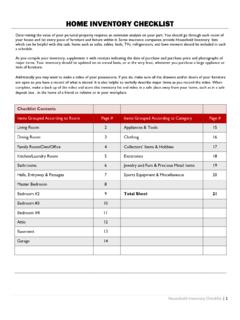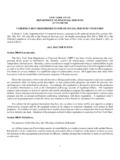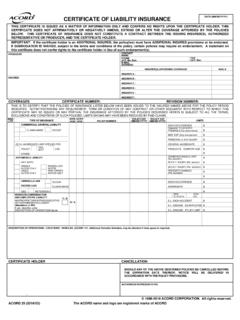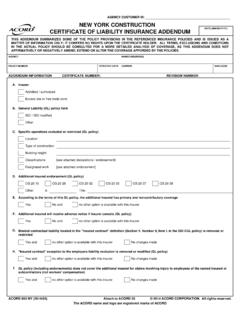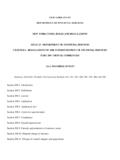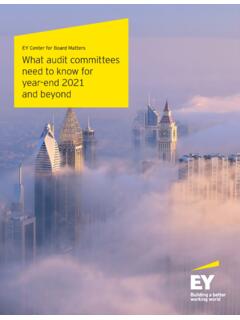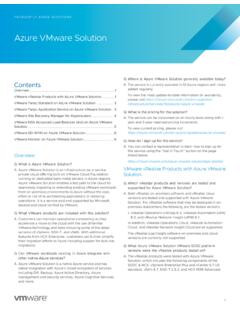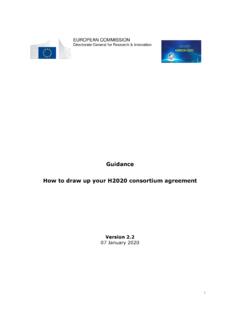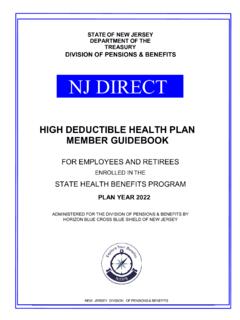Transcription of Guidance for New York Domestic Insurers on Managing the ...
1 1 Guidance for New York Domestic Insurers on Managing the Financial risks from Climate Change November 15, 2021 Table of Contents 1. Introduction .. 1 2. Financial risks from Climate Change .. 4 Physical and Transition risks .. 4 Distinctive Nature of Climate risks .. 5 3. DFS Expectations .. 5 Proportionate Approach .. 5 Materiality .. 6 Time Horizon for Consideration of Climate risks in Business Decisions .. 7 Uncertainty and Data Gaps .. 8 Timeline for Implementation .. 9 Risk Culture and Governance .. 9 Business Models and Strategies .. 11 Risk Management .. 12 Scenario Analysis .. 19 Public Disclosure .. 21 1. Introduction 1. As one of the most critical risk-management issues of our generation, climate change poses wide-ranging and material risks to the financial system. This is especially true for the insurance industry, where the physical and transition risks resulting from climate change affect both sides of Insurers balance sheets assets and liabilities as well as their business models.
2 Climate change also presents tremendous opportunities for Insurers , which play a critical role in the management of climate risks as risk managers, risk carriers, and investors, and are uniquely qualified to understand the pricing of risks . 2 These opportunities include helping communities be more resilient through inclusive and affordable insurance, contributing to climate change adaptation and mitigation, and enhancing the insurability of climate-related risks . To continue to thrive in the face of global competition, it is essential that New York Insurers both manage the financial risks and take advantage of the opportunities arising from climate change. 2. The Sixth Assessment Report of the Intergovernmental Panel on Climate Change ( IPCC ) states that [t]he scale of recent changes across the climate system as a whole and the present state of many aspects of the climate system are unprecedented over many centuries to many thousands of years.
3 1 Climate-related risks present unique challenges and require a strategic response by the insurance industry, including the acquisition of new knowledge, expertise, and tools. At the same time, general principles and approaches of good governance and risk management laid out in the New York Insurance Law and related regulations, and the Guidance manuals of the National Association of Insurance Commissioners ( NAIC ), apply to climate risks in the same way as other risks that may be more familiar to Insurers . 3. To support New York Domestic Insurers ( Insurers ) in Managing the financial risks from climate change ( climate risks ), the New York State Department of Financial Services ( DFS ) solicited comments on a proposed version of this Guidance on March 25, 2021. DFS received detailed comments from 45 parties, including industry trade groups, insurance companies, consumer advocates, climate experts, rating agencies, financial regulators, and individual citizens.
4 This final Guidance reflects DFS s careful consideration of all comments received. 4. This Guidance is informed by DFS s ongoing dialogue with the insurance industry over the past year, analysis of the potential climate risk exposure of Insurers assets, and collaboration with international and other regulatory bodies. This Guidance also reflects DFS s review of Insurers enterprise risk reports, Own Risk and Solvency Assessment ( ORSA ) summary reports, NAIC Climate Risk Disclosure Survey responses, and other voluntarily filed disclosure materials, including Task Force on Climate-related Financial Disclosures ( TCFD ) reports, sustainability reports, and disclosure questionnaires. Based on this review, there is a wide range of levels of maturity and sophistication among Insurers in terms of understanding and Managing climate risks , with larger Insurers typically more advanced than smaller ones, which in some cases have not yet considered climate risks .
5 5. This Guidance builds on relevant provisions of the New York Insurance Law, NAIC Financial Condition Examiners Handbook 2020 ( Handbook ), and NAIC ORSA Guidance Manual as of December 2017 ( ORSA Manual ). It is also modeled on publications, Guidance , and supervisory statements issued by international regulators and networks, such as the Bank of England Prudential Regulation Authority ( PRA ), the International Association of Insurance Supervisors ( IAIS ), the Sustainable Insurance Forum ( SIF ), the European Insurance and Occupational Pensions Authority ( EIOPA ), the European Central Bank ( ECB ), the Network for Greening the Financial System ( NGFS ), and the Dutch Central Bank. DFS is profoundly grateful for their work. 6. At a high level, international regulators expectations on Managing climate risks are consistent, including similar components, a focus on proportionality and long-term analysis, and the expectation of an increasing level of sophistication over time.
6 To ensure consistency across jurisdictions, international regulators have engaged in meaningful collaboration and coordination to develop international best 1 IPCC, Sixth Assessment Report Headline Statements from the Summary for Policymakers, August 9, 2021. 3 practices. DFS intends to continue to work closely with international and other regulators to reduce the compliance burden on Insurers . 7. Although no one is spared from the impact of climate change, it disproportionately affects disadvantaged communities, including low-income communities and communities of color, and feeds into the vicious circle of social inequality. DFS is committed to supporting fair, safe, and stable insurance markets for the benefit and protection of all New Yorkers. While this Guidance is focused on the financial stability of Insurers in the face of climate change, it is also crucial for Insurers to do their part to contribute to the low-carbon transition and climate adaptation efforts; support communities resilience to climate change, especially in disadvantaged communities that would be even more vulnerable to climate change if Insurers stop insuring or investing in these communities; and work with the public sector to find ways to close the protection gap and ensure that insurance is available and affordable throughout the State.
7 8. DFS expects this Guidance to serve as a basis for supervisory dialogue and to help Insurers familiarize themselves with climate risks and develop their capacity and processes for Managing them in accordance with the timelines specified in the Guidance . DFS intends to monitor Insurers progress in implementing the expectations in this 9. DFS will continue to develop its supervisory approach to Managing and disclosing climate risks , considering federal and state regulatory developments as well as evolving practices in the industry and in the national and international supervisory community. Over time, DFS expects its approach to shift from supporting Insurers progress in implementing DFS s supervisory expectations in accordance with the timelines specified in this Guidance , to active supervision against those expectations. Overview of DFS Supervisory Expectations 10. As explained in more detail below, DFS expects Insurers to take a strategic approach to Managing climate risks that considers both current and forward-looking risks and identifies actions required to manage those risks in a manner proportionate to the nature, scale, and complexity of Insurers businesses.
8 Specifically, an insurer should: I. Integrate the consideration of climate risks into its governance structure at the group or insurer entity level. The insurer s board should understand climate risks and maintain oversight over the management team responsible for Managing them. The roles of the board and management should be reflected in the company s risk appetite and organizational structure. II. When making business decisions, consider the current and forward-looking impact of climate-related factors on its business using time horizons that are appropriately tailored to the insurer, its activities, and the decisions being made. III. Incorporate climate risks into the insurer s existing financial risk management, including by embedding climate risks in its risk management framework and analyzing the impact of climate risks on existing risk factors. Climate risks should be considered in the company s ORSA. 2 To assist Insurers that are in the early stages of this work, examples are provided to illustrate the expectations in this Guidance , which should not be viewed as mandatory.
9 4 IV. Use scenario analysis to inform business strategies and risk assessment and identification. Scenarios should consider physical and transition risks , multiple carbon emissions and temperature pathways, and short-, medium-, and long-term horizons. V. Disclose its climate risks and engage with the TCFD and other initiatives when developing its disclosure approaches. 2. Financial risks from Climate Change Physical and Transition risks 11. Physical risks arise from the increasing frequency, severity, and volatility of acute events, such as hurricanes, floods, and wildfires. They also stem from chronic shifts in weather patterns, such as rising sea levels resulting in more flooding and coastal erosion, droughts disrupting agriculture production, and intensifying heat waves which are responsible for more annual deaths than any other weather-related Climate change has increased heat and precipitation extremes across the globe, as well as the likelihood of multiple perils occurring at once ( , concurrent heat waves and droughts, flooding caused by storm surge and extreme rainfall).
10 4 These risks directly affect property/casualty Insurers liabilities and the long-term viability of certain business lines. As the effects of climate change continue to unfold, physical risks will likely become more complex and harder to model, further challenging Insurers attempts to manage those risks . Climate-related natural disasters can also cause business disruption, destruction of capital, increased costs to recover from disasters, stress on infrastructure, reduced revenue, and migration. In turn, these can lead to lower residential and commercial property values, lower household wealth, lower corporate profitability, and stress on social and economic systems, translating into financial and credit market losses that affect Insurers assets. 12. Transition risks arise from society s transition towards a low-carbon economy, driven by policy and regulations (such as the potential introduction of a carbon tax or carbon allowances), low-carbon technology advancement, and shifting sentiment and societal preferences.
